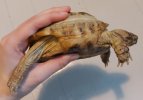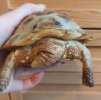Hello all!
Curious to see what the majority of members think about the Donoghue Ratio when it comes to determining healthy tortoise weights.
I saw a previous post on here about this subject, but it was from many years ago and is closed for comments. Was just wondering if anyone’s found anything new about the formula’s accuracy regarding various types of torts.
We find that it’s pretty accurate for our Western Hermanns and Redfoots— we see physical signs that tell us they’re overweight or underweight and the Donoghue Ratio confirms it. But we recently acquired elongateds and were wondering if they were included in the original study and if this ratio applies to them.
Thoughts/observations/opinions much appreciated.
I’ve included a picture of our Western Hermanns, Opal. She’s a thiccums 🤣😂🤣

Curious to see what the majority of members think about the Donoghue Ratio when it comes to determining healthy tortoise weights.
I saw a previous post on here about this subject, but it was from many years ago and is closed for comments. Was just wondering if anyone’s found anything new about the formula’s accuracy regarding various types of torts.
We find that it’s pretty accurate for our Western Hermanns and Redfoots— we see physical signs that tell us they’re overweight or underweight and the Donoghue Ratio confirms it. But we recently acquired elongateds and were wondering if they were included in the original study and if this ratio applies to them.
Thoughts/observations/opinions much appreciated.
I’ve included a picture of our Western Hermanns, Opal. She’s a thiccums 🤣😂🤣




